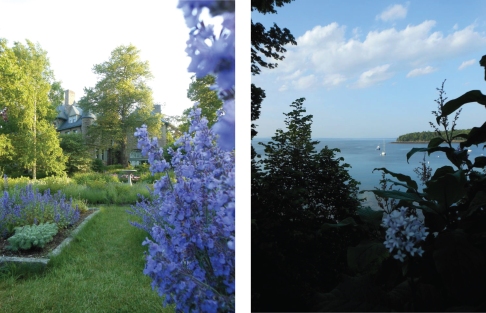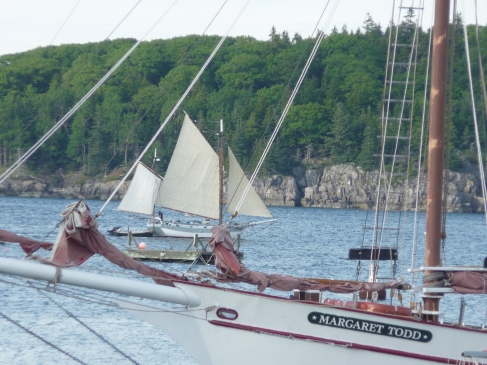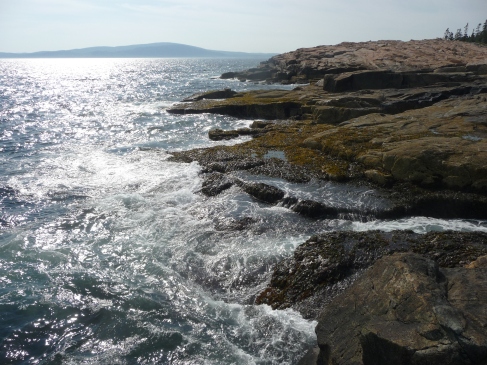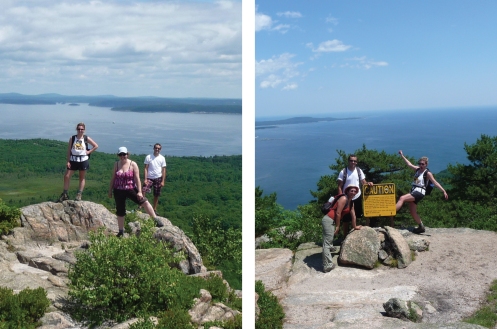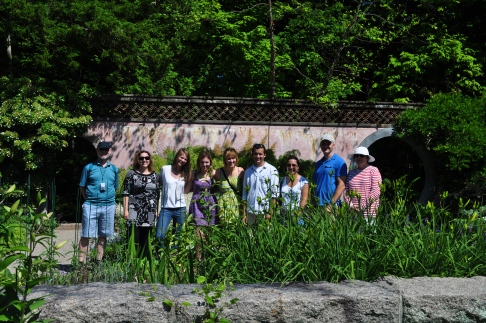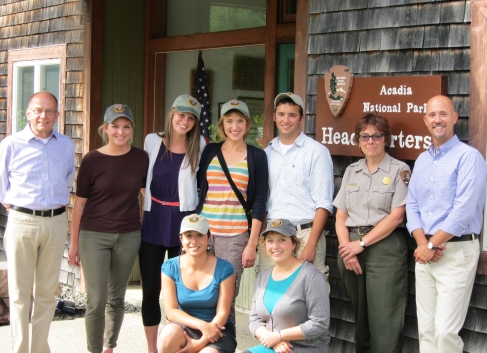Week 6: A summary and the end…
July 20, 2012 (Edited on July 24, 2012)
Looking back at the six weeks that we have spent here in Acadia National Park and in Mount Desert Island (MDI), there is so much to write about. I remember our first day and how we thought it was too quiet and didn’t know how time would pass without a TV. Now, that all sounds so funny because during these six weeks it was so busy that we were hardly able to find time to eat or sleep.
The first week, we were all nervous and excited about this rare opportunity and new adventure of ours. After being overwhelmed by the fear of poison ivy, deer ticks, black flies and even red ants, additional stories of accidents that had occurred in the park didn’t make things any easier. However, at that time we did not know how things would start changing and we would come to love this place even with all its fears.
The first week’s lecture topics were mostly focused on getting to know the park, its development, the importance of the visitor experience and some insights on park management. These were the subjects provided from the perspective of the park staff. On the other hand, George Curry from SUNY-ESF and Bob Page from the Olmsted Center, who were also the organizers of this field school and the staff leads for that week would inform us about cultural landscape preservation, as well as the methodology on how to conduct our inventory for those landscape features.
Our field trips during that week included a trip to the Visitor Center and Thunder Hole, a walking tour in Bar Harbor with Robert Krieg from Coplon Associates and the first experience of the carriage roads both on foot and on bikes, where we almost ran over some eggs that a turtle was laying at that very moment.
How can I describe our famous first field inventory? I don’t know if I should talk more about our intensive data collection efforts or the long hours of data entry? Either way, we successfully completed our first cultural landscape inventory for the unforgettable carriage road segment “ACAD CR 6-4”.
By the time that weekend approached, we were all so exhausted that no one really cared about sightseeing. If we ever knew that we would get to love this island so much, I don’t think we would have wasted any day of it. It’s just that we were all so out of shape that we could hardly get up on our feet that weekend.
Still, we did not neglect to discover the College of Atlantic (CoA) and the Atlantic Oceanside, as well as making a quick trip to the Cadillac Mountain and having some delicious popovers at Jordan Pond House. That weekend we also attended the Interpwoods Training on campus to learn more about the 1947 fire and the early visitors of Acadia, the Wabanakis and the Rusticators.
View of the historic Turrets Building and the Atlantic Oceanside from the gardens of the College of Atlantic
Then the second week came, with the staff leads Margaret Bryant from SUNY-ESF, and Jeff Killion from the Olmsted Center. This was the week where we refined our methodology for the cultural landscape inventory of the carriage roads. We were getting more comfortable with our method and getting even more familiar with Acadia National Park. Meanwhile, we were finding the opportunity to learn about regional planning and the uses of GIS, as well as hearing about the work that was being done at Mount Desert Island (MDI) in this direction.
That weekend, though we were still feeling exhausted by the week’s work, we made a quick trip to Bar Island by walking over a sand bar that would only appear during low tide. We also went on our first boat trip to Frenchman Bay with Margaret Todd.
Looking at Margaret Todd from Bar Harbor just before it took us on a sailboat adventure
On our third week, Margie Brown from the Olmsted center joined us. While she and the hiking trails crew explained us about preserving and maintaining the trails, Louis Moran from the University of Maine told us about vista management with examples right from the field. Though we were unfortunate enough to have the batteries of our suburban die with no radios in hand, we were still able to make it to the first release of the Acadia National Park quarters, which we had been so excited about over the past weeks. Stephanie Clement, from the Friends of Acadia was another very interesting speaker in one of our sessions during that week. We really enjoyed hearing about the work that they had been doing with the park over the last 20 years. We ended our week with the really productive webinar session on scenic resource management with Robin Hoffman from SUNY-ESF.
That weekend was the first time we finally got a chance to go on a proper hike to the top of the Dorr Mountain. After that spectacular view at the summit, our main purpose in the following weeks was to hike as many trails as possible. Meanwhile, we continued discovering the beaches of MDI both on the ocean and the lake side.
View of Sand Beach while climbing the Beehive
Fourth week with Eliot Foulds from the Olmsted Center passed so quickly with the 4th of July celebrations cutting right through it. That week we learned about facility management and compliance from Keith Johnston and David Popelka. While we were completing the first trip of our carriage road inventory, it was all clear to how the data we collected would be used and appreciated.
That week’s highlights were the 4th of July parade, the hike to Bubble Rock and a short trip to the Schoodic Peninsula. Some of us also climbed the really dangerous Beehive and Precipice trails that weekend.
A view from the Schoodic Point
The successful completion of the Beehive and Precipice hikes
When the fifth week had approached we all had fallen deep in love with the island. On top of that, visiting the gardens of Abby Aldrich Rockefeller, which were designed and created with the assistance of Beatrix Farrand between 1926 and 1930, was a great addition. That week’s staff leads were John Auwaerter from SUNY-ESF and Betsy Igleheart from the Olmsted Center. With Richard Hawks, head of the landscape architecture department at SUNY-ESF, joining us on the trip, we had an unforgettable time. That same day we also got a chance to visit the Asticou Azalea and Thuya Gardens, as well as a quick trip to the Garland Farm, the last home of Beatrix Farrand.
The Abby Aldrich Rockefeller Garden (from left to right: Richard Hawks, Catherine Ponte, Charlotte Evanofski, Sara Bonacquist, Margaret Johnson, Benjamin Boisclair, Tutku Ak, John Auwaerter, Elizabeth Igleheart)
Meanwhile, during the lectures we learned more on historic preservation planning, National Register Documentation, Section 106 and Section 110, which all helped clarify how cultural landscape preservation worked at the state and federal levels. During the fifth week, we also completed our second trip to the carriage roads, where we recorded the natural features, as well as the experiential characteristics of the roads.
At the end of the week, one evening we went for the whale watching experience. Luckily we were able to see both the Humpback and the Fin whales, just before getting sea sick on our way back. That weekend we also had an amazing hiking trip through the Penobscot trail, which was a beautiful summary of what we had experienced in the park during the past few weeks.
When week six had finally arrived, there was a bit of sadness over us. We knew that we still had much more to do and enjoy in the island, but we also knew that it was time to go. That week, we started working on our final presentation with the supervision of George Curry and Bob Page, who were joining us for the second time. The evening prior to our presentation at the headquarters, after briefly celebrating George’s birthday at the Cottage House, we luckily got a chance to see Ann Roberts Rockefeller, granddaughter of John D. Rockefeller Jr., who had come to talk about her most recently published book on the carriage roads. At the end, it seemed like everything was fitting like the pieces of a puzzle.
The day of our final presentation, which would also be the last day that “the Acadia Six” would all be together in MDI, went really well. There were around 50 people that had come to listen to our presentation and therefore we were quite nervous. When it all ended, there was both relief from completing our work and sadness for having to leave this beautiful island!
It was particularly hard to say goodbye to Rebecca Cole-Will from the Cultural Resource Division of Acadia National Park, who had helped us with every step of the field school during our six weeks of stay. Where she could not assist, there was David Manski from the Natural Resource Division, which we could have never gotten a chance to see the impressive whales if it wasn’t for him.
After our final presentation at the Acadia National Park Headquarters with our volunteer hats (back row, from left to right: George Curry, Sara Bonacquist, Charlotte Evanofski, Margaret Johnson, Benjamin Boisclair, Rebecca Cole-Will, Bob Page; front row, from left to right: Tutku Ak, Catherine Ponte)
Finally, I feel the need to mention about Heather Albert-Knopp and Ellyn Getz, the coordinators of the summer programs at the College of Atlantic, who both were so helpful during our stay at the Cottage House. Also, I can’t seem to leave out some of the new friends that we made; the red squirrel that greeted us every now and then, the funny hen and the guinea pig of the CoA, as well as our friendly mouse who we would dine with almost every night. Luckily and surprisingly, there was not a single incident of a tick bite at the end of the six weeks of the field school.
George Curry and the Acadia Six at the Cottage House (from left to right: Tutku Ak, Margaret Johnson, Sara Bonacquist, Benjamin Boisclair, Charlotte Evanofski, Catherine Ponte, George Curry)
More stories and pictures about our summer field school can be found at http://www.facebook.com/AcadiaNationalParkSummerFieldSchool12

